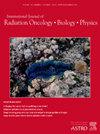Neoadjuvant Chemotherapy with Trastuzumab with or without Concurrent Radiotherapy in HER2-Positive Inoperable Locally Advanced Breast Cancer: A Phase 2 Randomized Trial (NEOTRAC)
IF 6.5
1区 医学
Q1 ONCOLOGY
International Journal of Radiation Oncology Biology Physics
Pub Date : 2025-10-14
DOI:10.1016/j.ijrobp.2025.08.036
引用次数: 0
Abstract
Purpose/Objective(s)
The role of neoadjuvant concurrent chemoradiotherapy (NACCRT) with anti-HER2 therapy remains unexplored. We report the first phase 2 randomized controlled trial (RCT) evaluating whether adding NACCRT and trastuzumab improves pathological complete response (pCR) in HER2-positive inoperable locally advanced breast cancer (LABC).
Materials/Methods
Patients with newly diagnosed HER2-Positive inoperable LABC were randomized in a 1:1 ratio to receive either NACT with trastuzumab (Arm A) or NACCRT and trastuzumab (Arm B). Both arms received four cycles of Adriamycin and Cyclophosphamide (q 3 weekly), followed by four cycles of Paclitaxel (q 3 weekly) and nine weekly cycles of Trastuzumab. In Arm B, patients received concurrent radiotherapy (RT) to a total dose of 46 Gy to the breast and nodal areas along with paclitaxel and trastuzumab, followed by mastectomy. In contrast, patients in Arm A received postmastectomy RT to a total dose of 50 Gy after NACT and surgery. Adjuvant trastuzumab (q 3 weekly) was continued for one year in both arms. Primary endpoint was pCR while secondary endpoints included survival, toxicity, and treatment duration.
Results
Among 118 enrolled patients (Arm A: 62; Arm B: 56), 113 underwent surgery (Arm A: 58; Arm B: 55). Five patients (Arm A: 4; Arm B: 1) with complete clinical response (cCR) declined surgery. The median age was 50 years (range: 24–65), and all had stage III disease (IIIA: 40/118, [33.9%]; IIIB: 68/118 [57.6%]; IIIC: 10/118, [8.5%]). pCR rates were 46.6% (27/58) in Arm A versus 50.9% (28/55) in Arm B (P= 0.64), with no differences by subgroups (hormone receptor status, menopausal status, tumor size and stage grouping). At a median follow-up of 27 months, survival outcomes were similar. Event-free survival (EFS) was 81.0% (95% CI: 66.2–89.8) in Arm A versus 81.9% (65.2–91.1) in Arm B (P = 0.79). Overall survival (OS) was 93.0% (80.1–97.9) versus 95.1% (81.3–98.8) (P = 0.88) in Arms A and B respectively. NACCRT significantly reduced treatment duration (median 189 vs. 255 days, P < 0.00001). Surgical wound morbidity occurred in 6.9% (4/58) of Arm A versus 16.4% (9/55) of Arm B (P = 0.15). Grade 3 radiation dermatitis of 5.5% (3/55) and neutropenia 3.6% (2/55) were observed only in Arm B. No cardiac toxicity occurred. Among cCR patients declining surgery, 1/4 in Arm A progressed, while all others (3/4 Arm A, 1/1 Arm B) remained disease-free.
Conclusion
To our knowledge, this is the first RCT of NACCRT with trastuzumab. While pCR was higher with NACCRT, the difference was not significant. NACCRT was well tolerated, showed no added cardiac toxicity, and significantly reduced treatment duration, potentially lowering hospital visits and income loss. It may be a feasible option for patients seeking shorter, effective treatment. Further studies are warranted to explore whether the benefit of shortened overall treatment duration with NACCRT can be extended to the adjuvant setting in breast cancer management.
曲妥珠单抗联合或不联合放疗治疗her2阳性不能手术的局部晚期乳腺癌:一项2期随机试验(NEOTRAC)
目的/目的:新辅助同步放化疗(NACCRT)与抗her2治疗的作用仍未探索。我们报告了第一项2期随机对照试验(RCT),该试验评估了NACCRT和曲妥珠单抗是否能改善her2阳性不能手术的局部晚期乳腺癌(LABC)的病理完全缓解(pCR)。材料/方法新诊断her2阳性不能手术的LABC患者按1:1的比例随机接受NACT联合曲妥珠单抗(a组)或NACCRT联合曲妥珠单抗(B组)。两组均接受4个周期的阿霉素和环磷酰胺治疗(每周3次),随后是4个周期的紫杉醇治疗(每周3次)和9个周期的曲妥珠单抗治疗。在B组中,患者接受总剂量为46 Gy的乳房和淋巴结放射治疗(RT)以及紫杉醇和曲妥珠单抗,随后进行乳房切除术。相比之下,A组患者在NACT和手术后接受乳房切除术后放疗,总剂量为50 Gy。辅助曲妥珠单抗(每周3次)在两组中持续治疗一年。主要终点是pCR,次要终点包括生存、毒性和治疗时间。结果118例入组患者(A组62例,B组56例)中,113例接受手术治疗(A组58例,B组55例)。临床完全缓解(cCR)的5例患者(A组4例,B组1例)拒绝手术。中位年龄50岁(范围:24-65岁),均为III期疾病(IIIA: 40/118, [33.9%]; IIIB: 68/118, [57.6%]; IIIC: 10/118,[8.5%])。A组的pCR率为46.6% (27/58),B组为50.9% (28/55)(P= 0.64),亚组(激素受体状态、绝经状态、肿瘤大小和分期)无差异。在中位27个月的随访中,生存结果相似。A组无事件生存率(EFS)为81.0% (95% CI: 66.2-89.8), B组为81.9% (65.2-91.1)(P = 0.79)。A组和B组总生存率(OS)分别为93.0%(80.1 ~ 97.9)和95.1% (81.3 ~ 98.8)(P = 0.88)。NACCRT显著缩短了治疗时间(中位189天vs. 255天,P < 0.00001)。A组手术伤口发生率为6.9% (4/58),B组为16.4% (9/55)(P = 0.15)。3级放射性皮炎5.5%(3/55),中性粒细胞减少3.6%(2/55)。在拒绝手术的cCR患者中,1/4的A组患者病情进展,而其他所有患者(3/4 A组,1/1 B组)均无疾病。据我们所知,这是首个使用曲妥珠单抗进行NACCRT的RCT。NACCRT的pCR值较高,但差异不显著。NACCRT耐受性良好,没有增加心脏毒性,显著缩短治疗时间,可能降低医院就诊次数和收入损失。对于寻求短期有效治疗的患者来说,这可能是一个可行的选择。需要进一步的研究来探讨NACCRT缩短总治疗时间的益处是否可以扩展到乳腺癌治疗的辅助设置。
本文章由计算机程序翻译,如有差异,请以英文原文为准。
求助全文
约1分钟内获得全文
求助全文
来源期刊
CiteScore
11.00
自引率
7.10%
发文量
2538
审稿时长
6.6 weeks
期刊介绍:
International Journal of Radiation Oncology • Biology • Physics (IJROBP), known in the field as the Red Journal, publishes original laboratory and clinical investigations related to radiation oncology, radiation biology, medical physics, and both education and health policy as it relates to the field.
This journal has a particular interest in original contributions of the following types: prospective clinical trials, outcomes research, and large database interrogation. In addition, it seeks reports of high-impact innovations in single or combined modality treatment, tumor sensitization, normal tissue protection (including both precision avoidance and pharmacologic means), brachytherapy, particle irradiation, and cancer imaging. Technical advances related to dosimetry and conformal radiation treatment planning are of interest, as are basic science studies investigating tumor physiology and the molecular biology underlying cancer and normal tissue radiation response.

 求助内容:
求助内容: 应助结果提醒方式:
应助结果提醒方式:


